Enhanced Treatment of Basic Red 46 by Ozonation in a Rotating Packed Bed with Liquid Detention
Abstract
:1. Introduction
2. Materials and Methods
2.1. Materials and Procedure
2.2. Analytical Methods
3. Results and Discussion
3.1. Effect of Liquid Detention
3.2. Effect of Rotational Speed of RPB
3.3. Effect of Gaseous Ozone Concentration
3.4. Effect of Initial BR-46 Concentration
3.5. Effect of Liquid Flow Rate
3.6. Effect of Gas Flow Rate
4. Conclusions
Author Contributions
Funding
Data Availability Statement
Acknowledgments
Conflicts of Interest
References
- Sen, S.K.; Raut, S.; Bandyopadhyay, P.; Raut, S. Fungal decolouration and degradation of azo dyes: A review. Fungal Biol. Rev. 2016, 30, 112–133. [Google Scholar] [CrossRef]
- Kong, S.; Zhang, W.; Gao, S.; Chen, D. Immobilized CeO2 for adsorption of azo dye. J. Exp. Nanosci. 2019, 14, 107–115. [Google Scholar] [CrossRef]
- Shi, Y.; Yang, Z.; Xing, L.; Zhang, X.; Li, X.; Zhang, D. Recent advances in the biodegradation of azo dyes. World J. Microb. Biot. 2021, 37, 1–18. [Google Scholar] [CrossRef] [PubMed]
- Torres-Luna, J.A.; Giraldo-Gómez, G.I.; Sanabria-González, N.R.; Carriazo, J.G. Catalytic degradation of real-textile azo-dyes in aqueous solutions by using Cu–Co/halloysite. Bull. Mater. Sci. 2019, 42, 137. [Google Scholar] [CrossRef]
- Kapoor, R.T.; Sivamani, S. Adsorptive Potential of Orange Peel Biochar for Removal of Basic Red Dye and Phytotoxicity Analysis. Chem. Eng. Technol. 2023, 46, 756–765. [Google Scholar] [CrossRef]
- Guo, Y.; Zeng, Z.; Zhu, Y.; Huang, Z.; Cui, Y.; Yang, J. Catalytic oxidation of aqueous organic contaminants by persulfate activated with sulfur-doped hierarchically porous carbon derived from thiophene. Appl. Catal. B Environ. 2018, 220, 635–644. [Google Scholar] [CrossRef]
- Malik, S.N.; Ghosh, P.C.; Vaidya, A.N.; Mudliar, S.N. Hybrid ozonation process for industrial wastewater treatment: Principles and applications: A review. J. Water Process Eng. 2020, 35, 101193. [Google Scholar] [CrossRef]
- Toro, C.A.T.; Dagostin, J.L.A.; Vasques, É.C.; Spier, M.R.; Igarashi-Mafra, L.; Dantas, T.L.P. Effectiveness of ozonation and catalytic ozonation (iron oxide) in the degradation of sunset yellow dye. Can. J. Chem. Eng. 2020, 98, 2530–2544. [Google Scholar] [CrossRef]
- Otieno, B.; Apollo, S.; Kabuba, J.; Naidoo, B.; Simate, G.; Ochieng, A. Ozonolysis pre-treatment of waste activated sludge for solubilization and biodegradability enhancement. J. Environ. Chem. Eng. 2019, 7, 102945. [Google Scholar] [CrossRef]
- Otieno, B.; Apollo, S.; Kabuba, J.; Naidoo, B.; Ochieng, A. Ozonolysis post-treatment of anaerobically digested distillery wastewater effluent. Ozone Sci. Eng. 2019, 41, 551–561. [Google Scholar] [CrossRef]
- Dang, T.T.; Do, V.M.; Trinh, V.T. Nano-catalysts in ozone-based advanced oxidation processes for wastewater treatment. Curr. Pollut. Rep. 2020, 6, 217–229. [Google Scholar] [CrossRef]
- Ouali, S.; Biard, P.F.; Loulergue, P.; You, R.; Nasrallah, N.; Maachi, R.; Szymczyk, A. Water treatment intensification using a monophasic hybrid process coupling nanofiltration and ozone/hydrogen peroxide advanced oxidation. Chem. Eng. J. 2022, 437, 135263. [Google Scholar] [CrossRef]
- Li, R.; Siriwardena, D.; Speed, D.; Fernando, S.; Holsen, T.M.; Thagard, S.M. Treatment of azole-containing industrial wastewater by the fenton process. Ind. Eng. Chem. Res. 2021, 60, 9716–9728. [Google Scholar] [CrossRef]
- Tichonovas, M.; Krugly, E.; Jankunaite, D.; Racys, V.; Martuzevicius, D. Ozone-UV-catalysis based advanced oxidation process for wastewater treatment. Environ. Sci. Pollut. Res. 2017, 24, 17584–17597. [Google Scholar] [CrossRef] [PubMed]
- Zhang, H.; Zhang, Y.; Qiao, T.; Hu, S.; Liu, J.; Zhu, R.; Yang, K.; Li, S.; Zhang, L. Study on ultrasonic enhanced ozone oxidation of cyanide-containing wastewater. Sep. Purif. Technol. 2022, 303, 122258. [Google Scholar] [CrossRef]
- Qi, F.; Zeng, Z.; Wen, Q.; Huang, Z. Enhanced organics degradation by three-dimensional (3D) electrochemical activation of persulfate using sulfur-doped carbon particle electrode: The role of thiophene sulfur functional group and specific capacitance. J. Hazard. Mater. 2021, 416, 125810. [Google Scholar] [CrossRef]
- Wang, J.; Yuan, R.; Feng, Z.; Ma, F.; Zhou, B.; Chen, H. The advanced treatment of textile printing and dyeing wastewater by hydrodynamic cavitation and ozone: Degradation, mechanism, and transformation of dissolved organic matter. Environ. Res. 2022, 215, 114300. [Google Scholar] [CrossRef]
- Muniyasamy, A.; Sivaporul, G.; Gopinath, A.; Lakshmanan, R.; Altaee, A.; Achary, A.; Chellam, P.V. Process development for the degradation of textile azo dyes (mono-, di-, poly-) by advanced oxidation process-Ozonation: Experimental & partial derivative modelling approach. J. Environ. Manag. 2020, 265, 110397. [Google Scholar] [CrossRef]
- Parsa, J.B.; Negahdar, S.H. Treatment of wastewater containing Acid Blue 92 dye by advanced ozone-based oxidation methods. Sep. Purif. Technol. 2012, 98, 315–320. [Google Scholar] [CrossRef]
- Wu, T.; Zhang, H.; Liu, Z.; Liu, T.; Jiang, P.; Arowo, M.; Shao, L. Amaranth wastewater treatment by intensified ozonation in a rotating zigzag bed. J. Water Process Eng. 2022, 49, 102984. [Google Scholar] [CrossRef]
- Gao, W.; Song, Y.; Jiao, W.; Liu, Y. A catalyst-free and highly efficient approach to ozonation of benzyl alcohol to benzoic acid in a rotating packed bed. J. Taiwan Inst. Chem. Eng. 2019, 103, 1–6. [Google Scholar] [CrossRef]
- Han, R.; Fang, X.; Song, Y.; Wang, L.; Lu, Y.; Ma, H.; Xiao, H.; Shao, L. Study on the oxidation of ammonium sulfite by ozone in a rotating packed bed. Chem. Eng. Process. 2022, 173, 108820. [Google Scholar] [CrossRef]
- Yang, P.; Luo, S.; Liu, H.; Jiao, W.; Liu, Y. Aqueous ozone decomposition kinetics in a rotating packed bed. J. Taiwan Inst. Chem. Eng. 2019, 96, 11–17. [Google Scholar] [CrossRef]
- Karimi-Shamsabadi, M.; Behpour, M. Comparing photocatalytic activity consisting of Sb2S3 and Ag2S on the TiO2–SiO2/TiO2 nanotube arrays-support for improved visible-light-induced photocatalytic degradation of a binary mixture of basic blue 41 and basic red 46 dyes. Int. J. Hydrogen Energy 2021, 46, 26989–27013. [Google Scholar] [CrossRef]
- Berkani, M.; Kadmi, Y.; Bouchareb, M.K.; Bouhelassa, M.; Bouzaza, A. Combinatıon of a Box-Behnken design technique with response surface methodology for optimization of the photocatalytic mineralization of CI Basic Red 46 dye from aqueous solution. Arab. J. Chem. 2020, 13, 8338–8346. [Google Scholar] [CrossRef]
- Liu, T.; Wang, D.; Liu, H.; Zhao, W.; Wang, W.; Shao, L. Rotating packed bed as a novel disinfection contactor for the inactivation of E. coli by ozone. Chemosphere 2019, 214, 695–701. [Google Scholar] [CrossRef] [PubMed]
- Qiao, J.; Luo, S.; Yang, P.; Jiao, W.; Liu, Y. Degradation of nitrobenzene-containing wastewater by ozone/persulfate oxidation process in a rotating packed bed. J. Taiwan Inst. Chem. Eng. 2019, 99, 1–8. [Google Scholar] [CrossRef]
- Wang, L.; Yun, J.; Zhang, H.; Si, J.; Fang, X.; Shao, L. Degradation of Bisphenol A by ozonation in rotating packed bed: Effects of operational parameters and co-existing chemicals. Chemosphere 2021, 274, 129769. [Google Scholar] [CrossRef]
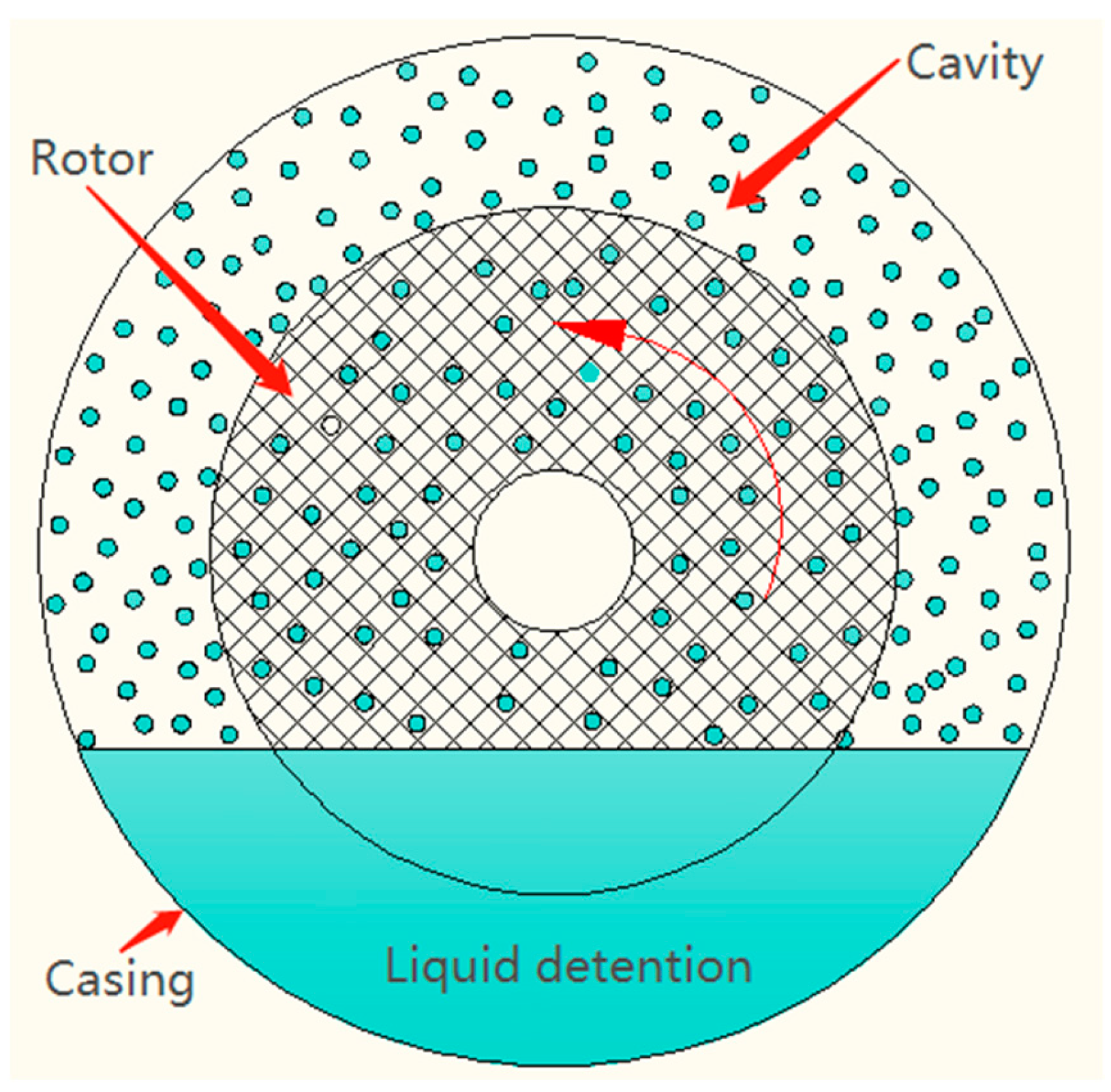

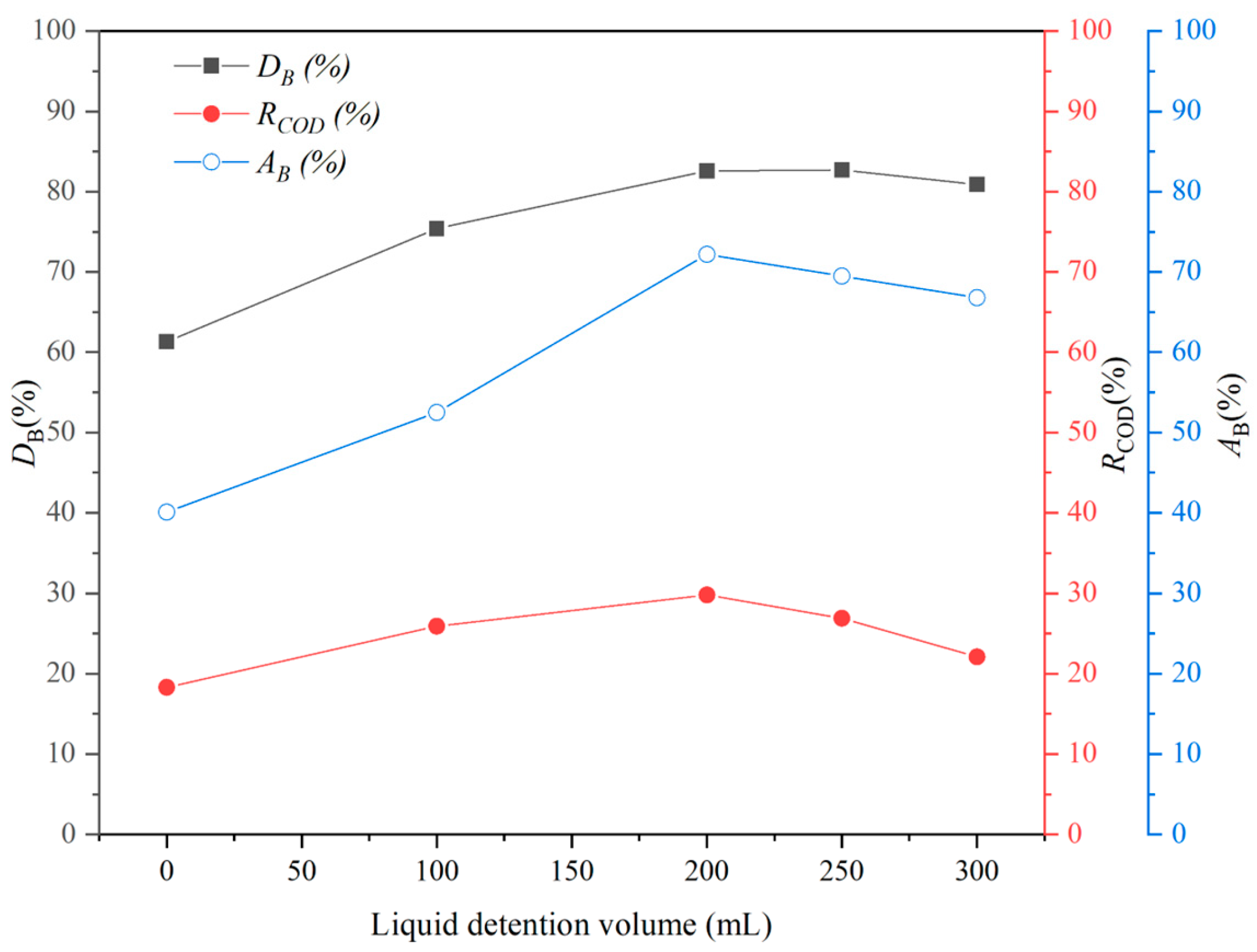
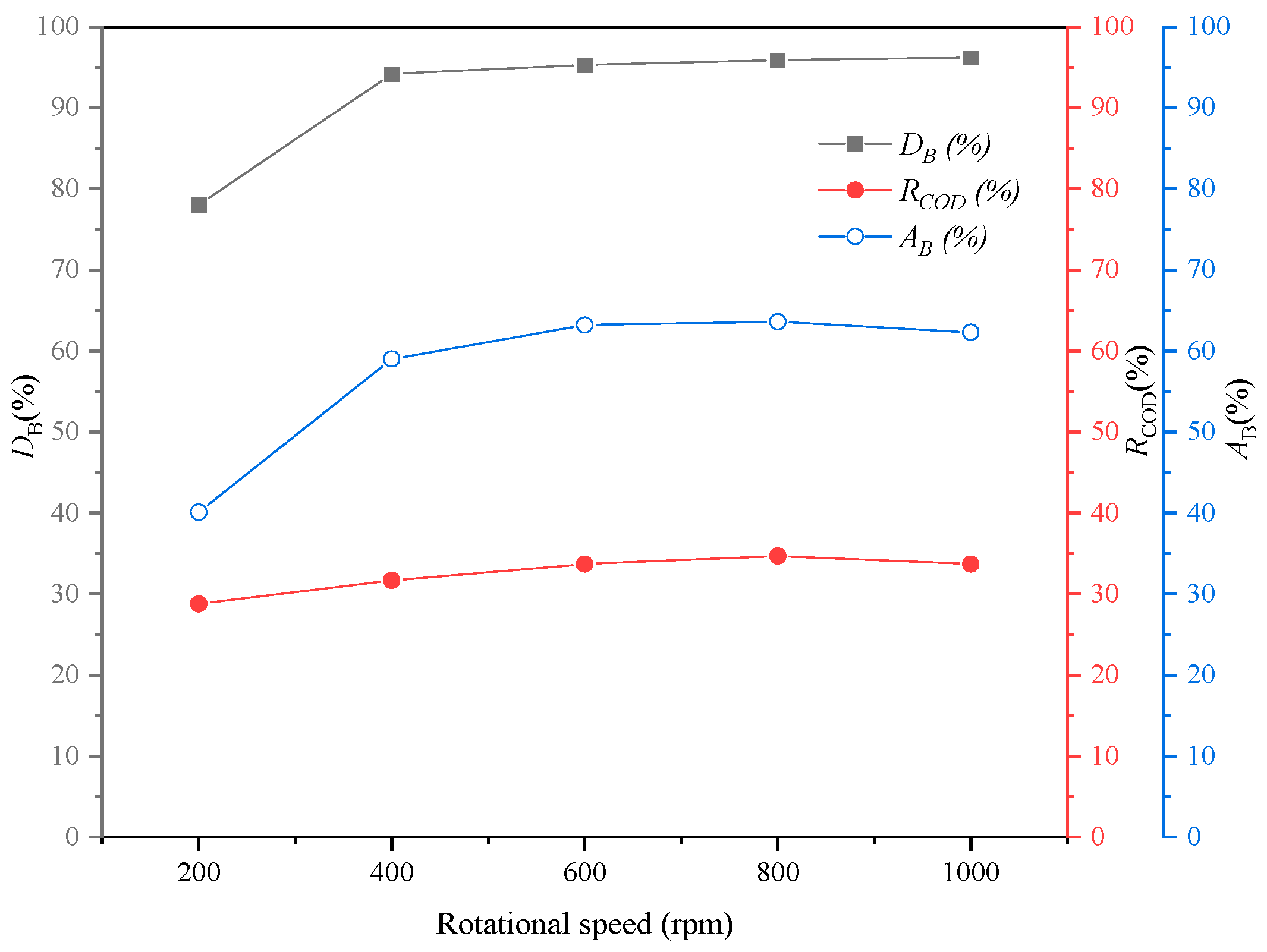

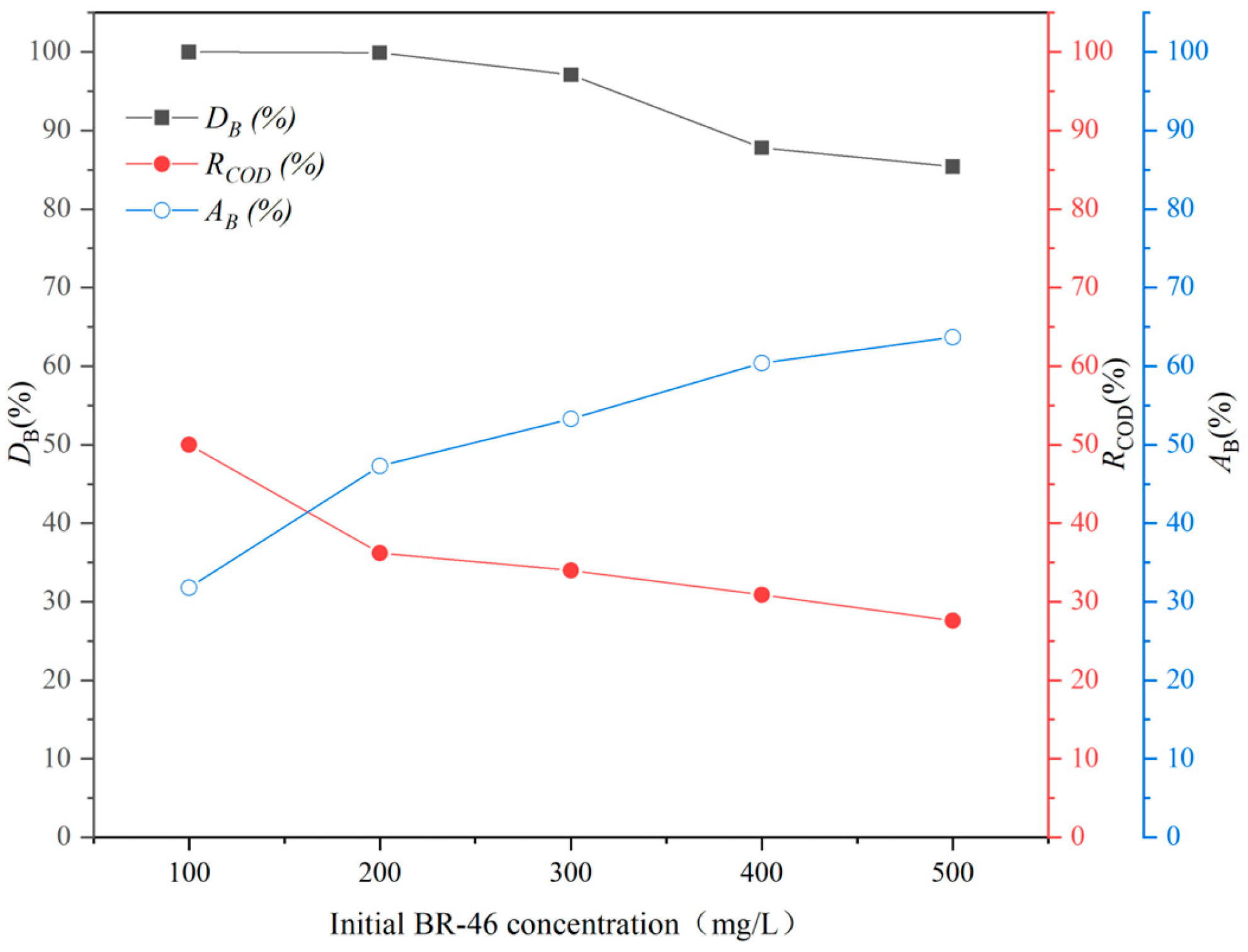

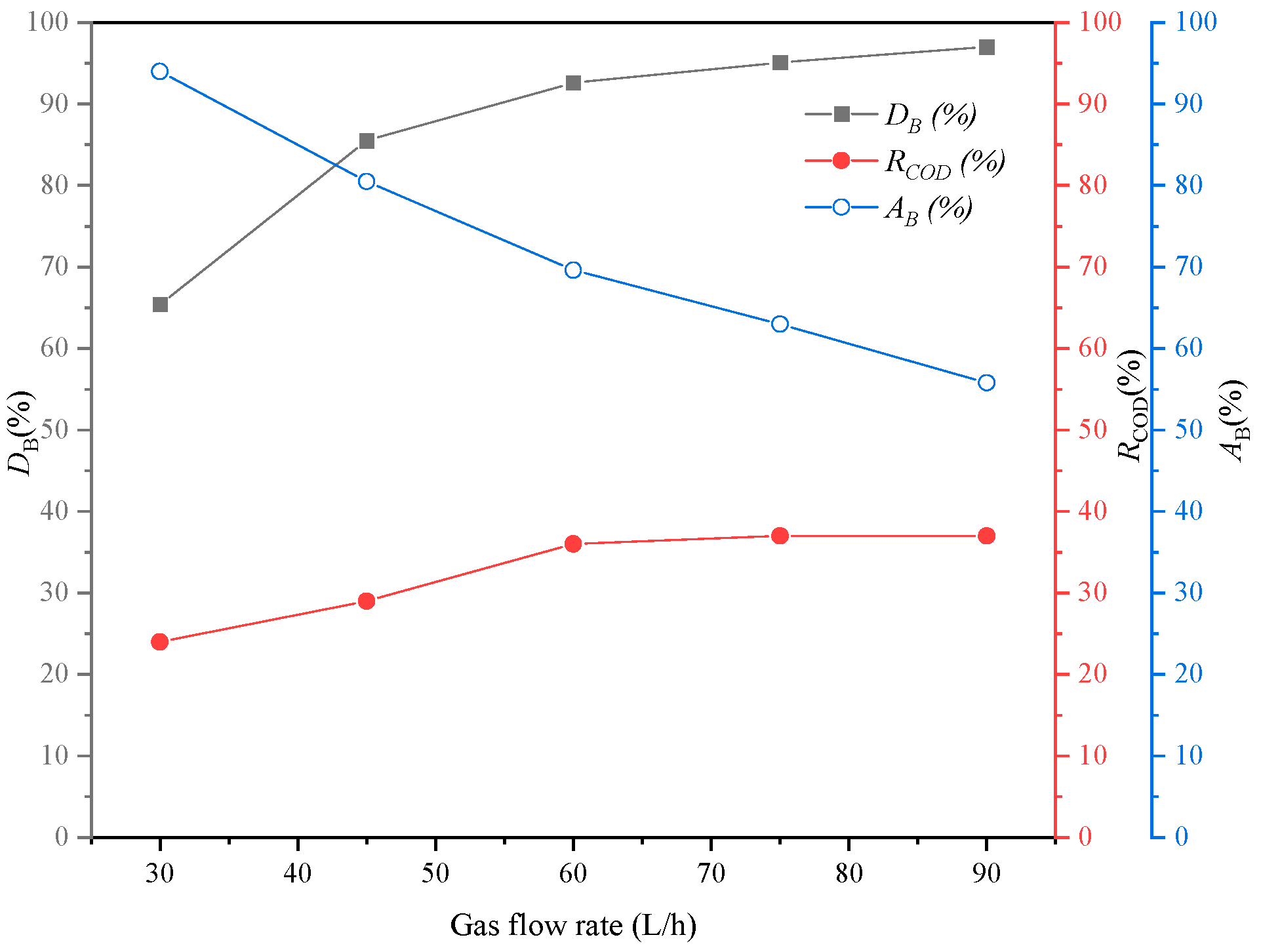
| Item | Value |
|---|---|
| Inner diameter of packing | 40 mm |
| Outer diameter of packing | 120 mm |
| Thickness of packing | 15 mm |
| Material of packing | Stainless steel wire mesh |
| Specific surface area of packing | 522 m2/m3 |
| Porosity of packing | 97% |
| Inner diameter of casing | 180 mm |
Disclaimer/Publisher’s Note: The statements, opinions and data contained in all publications are solely those of the individual author(s) and contributor(s) and not of MDPI and/or the editor(s). MDPI and/or the editor(s) disclaim responsibility for any injury to people or property resulting from any ideas, methods, instructions or products referred to in the content. |
© 2023 by the authors. Licensee MDPI, Basel, Switzerland. This article is an open access article distributed under the terms and conditions of the Creative Commons Attribution (CC BY) license (https://creativecommons.org/licenses/by/4.0/).
Share and Cite
Xu, P.; Wu, T.; Xiang, Y.; Yun, J.; Shao, L. Enhanced Treatment of Basic Red 46 by Ozonation in a Rotating Packed Bed with Liquid Detention. Processes 2023, 11, 1345. https://doi.org/10.3390/pr11051345
Xu P, Wu T, Xiang Y, Yun J, Shao L. Enhanced Treatment of Basic Red 46 by Ozonation in a Rotating Packed Bed with Liquid Detention. Processes. 2023; 11(5):1345. https://doi.org/10.3390/pr11051345
Chicago/Turabian StyleXu, Peng, Tianyang Wu, Yang Xiang, Jimmy Yun, and Lei Shao. 2023. "Enhanced Treatment of Basic Red 46 by Ozonation in a Rotating Packed Bed with Liquid Detention" Processes 11, no. 5: 1345. https://doi.org/10.3390/pr11051345






